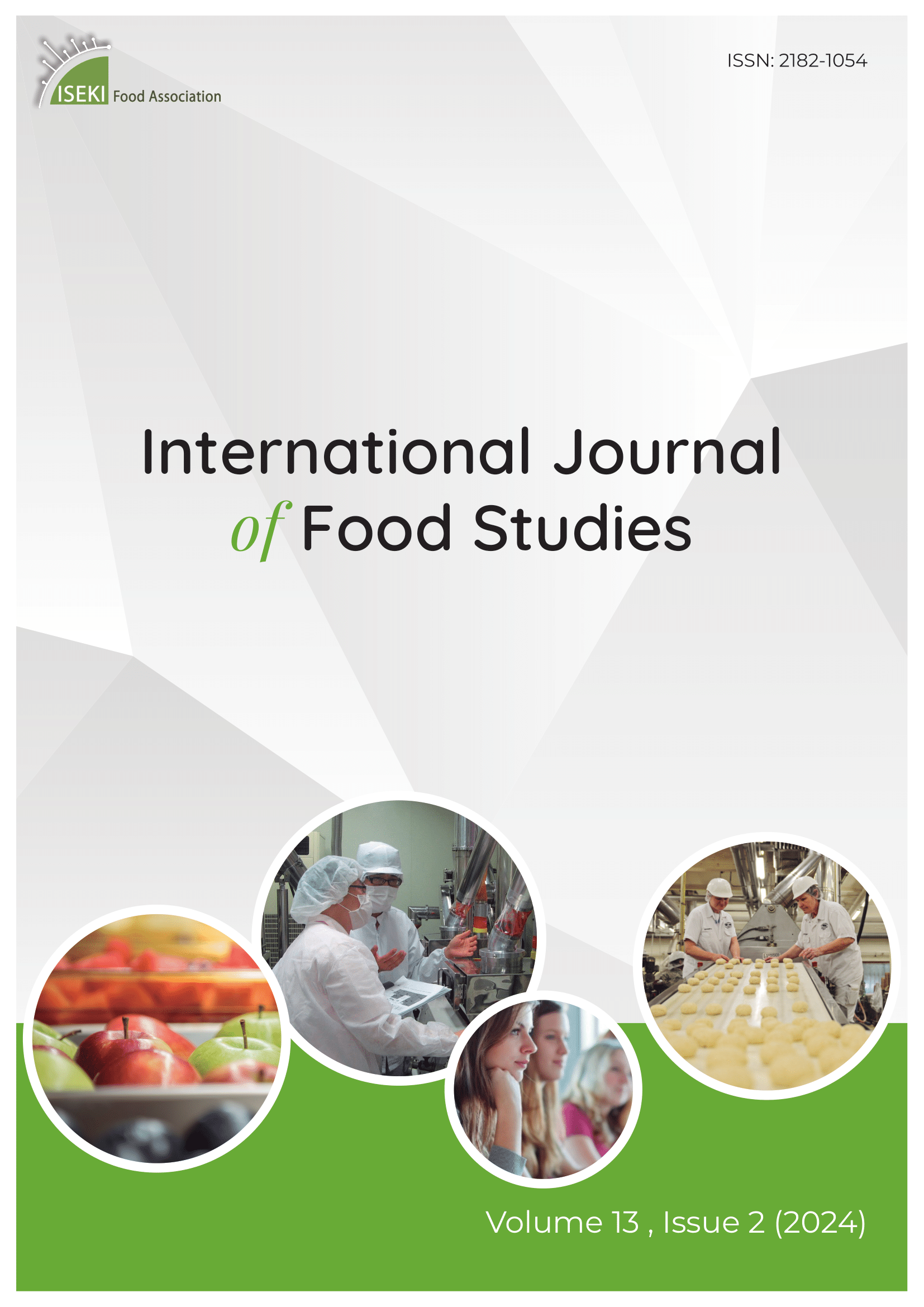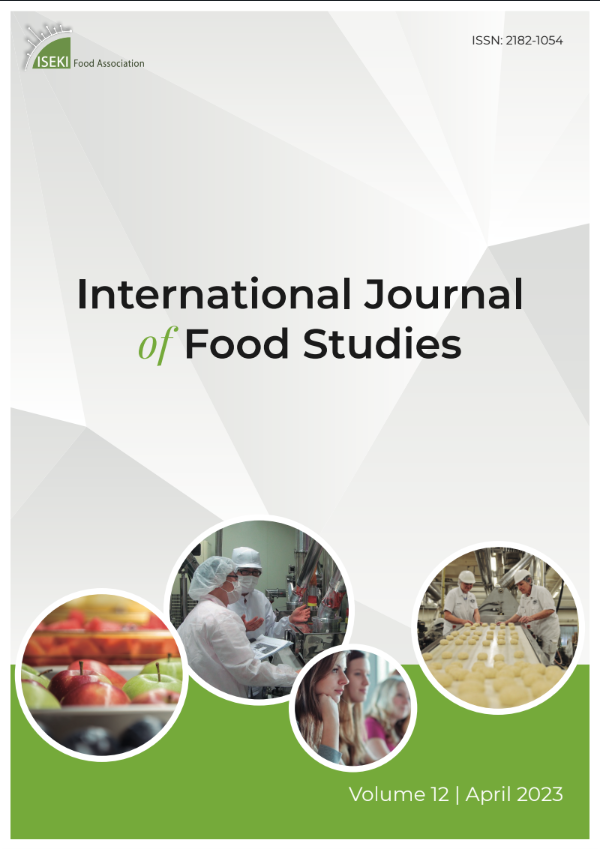Current issue

Volume 13, Issue 2, 2024
Online ISSN: 2182-1054
Volume 13 , Issue 2, (2024)
Published: 18.10.2024.
Open Access
All issues
Contents
18.10.2022.
Original scientific paper
Optimization of bromelain isolation from honi pineapple crown
Bromelain is a proteolytic enzyme that can be found in all parts of pineapple plant varieties. Pineapple crown (PC) has higher bromelain activity than other pineapple wastes such as peels and leaves. This study isolated bromelain from one variety of PC, namely Honi, and determined the optimum drying temperature as well as concentration of ammonium sulphate to obtain the best bromelain characteristics such as protein content, unit activity and specific activity. Honi PC was dried at various drying temperatures (35, 40, 45, 50, and 55 °C), and then extracted and purified using ammonium sulphate in various concentrations (20, 40, 60, and 80%), in order, to get bromelain. Furthermore, the yield of isolated bromelain was calculated and the protein content, unit activity and specific activity of bromelain characterised. The highest yield of crude bromelain (CB) was achieved at 35 °C. However, the highest protein level, unit activity and specific activity of CB were achieved at 55 °C (p < 0.05). Purification of CB using concentrations of ammonium sulphate in the range 40 to 80% resulted in a higher protein level (p < 0.05). The highest unit activity and specific activity of bromelain were achieved at a 60% concentration of ammonium sulphate (p < 0.05). 55 °C and 60% were the optimum drying temperature and concentration of ammonium sulphate respectively to achieve the best characteristics (2.16% protein level, 1.61 U/mL unit activity and 0.75 U/mg specific activity) for bromelain isolated from Honi PC. Honi PC isolated bromelain was shown to inhibit the browning reaction on apple fruits. The agroindustry waste product, Honi PC, has potential as a future alternative bromelain source.
Siti Susanti, Heni Rizqiati, Ivana F. Lisandi, Nuryanto, Fahmi Arifan
18.10.2022.
Original scientific paper
Handling Practices and Quality Attributes Along the Supply Chain of gboma (Solanum Macrocarpon): A Leafy Vegetable in Southern Benin
gboma is a leafy vegetable commonly consumed in Benin, which plays an important role in food security. This study assessed the handling and preservation practices as well as quality attributes of gboma along the supply chain in Southern Benin. A survey among 785 people (285 producers, 180 whole salers/retailers, and 326 consumers) living in four Departments of Benin was conducted to evaluate the consumption frequency, the transportation mode, the preservation methods and quality attributes of gboma during purchasing. The survey revealed that, in general, gboma sauce is consumed twice to three times a month in all the departments covered. Different practices, including humidification, were used to preserve the leaves during selling. Traditional baskets or old clothes were used for the transportation and storage of gboma. Important quality attributes mostly used by actors during purchasing were freshness and color followed by physical damage and, to a lesser extent, weight and leaf surface at different degrees. gboma is currently sold in informal markets; however, improving handling and selling practices could preserve the freshness of this leafy vegetable that could then be placed in conventional supermarkets. Thereby, the selling and consequently the production level will increase, with positive impact on the income of producers.
Fernande Honfo, Mênouwesso H. Hounhouigan, D. Sylvain Dabade, Mathias Hounsou, Barbara Gotz, Antonia Albrecht, Judith Kreyenschmidt, D. Joseph Hounhouigan
18.10.2022.
Original scientific paper
Antioxidant, Antimicrobial and Physicochemical Properties of Beef Sausages Enriched with an Aqueous Extract of Senduduk (Melastoma malabathricum L.) Leaf
The use of natural products in sausages has become a new trend for health reasons. A natural product that could be incorporated into sausages is an extract of the senduduk (Melastoma malabathricum L.) leaf. Senduduk is an abundant shrub herb in Indonesia. This kind of plant is mostly used as a traditional medical remedy and as an ingredient in some culinary recipes. This study was carried out to investigate the effect of an aqueous extract of senduduk leaf (SLE) on the antioxidant, antimicrobial and physicochemical properties of beef sausage. Four treatments were used: ingredients consisting of beef, vegetable oil, skim milk, tapioca, salt, phosphate, ice cubic, garlic, pepper, dan nutmeg as a Control; the Control ingredients plus 0.01% of butylated hydroxytoluene (BHT); the Control ingredients plus 0.83% of SLE (SLE-1), and the Control ingredients plus 1.1% of SLE (SLE-2). All ingredients of each formula were homogenously blended and the sausage mix was cooked. The addition of BHT and SLE affected the proximate composition, with the moisture content decreasing as the duration of chilled storage increased. The addition of SLE lowered the pH and aw value and both tended to increase during chilled storage. SLE also enhanced the WHC of the sausages which increased in value during chilled storage. The addition of BHT and SLE could increase the antioxidant activity of the sausages as indicated by scavenging DPPH free radicals. SLE in sausages could inhibit microbial growth during chilled storage. It can be summarized that the addition of an aqueous extract of senduduk could improve the physicochemical, antioxidant and antimicrobial properties of beef sausages.
Suharyanto Suharyanto, Nuraini Henny, Suryati Tuti, Irma Isnafia Arief, Dondin Sajuthi
18.04.2022.
Original scientific paper
Chemical composition, nutritional, functional and pasting properties of yellow root cassava grits and african yam bean flour blends
The effect of African Yam Bean (AYB) flour substitution on the nutritional, functional and pasting properties of yellow root cassava grits was investigated. Cassava grits were obtained by peeling, washing, cutting (5.5 cm thickness in cubes), soaking (72 h, 28±2 °C), dewatering, roasting (120 °C, 20 min), sieving and milling. Roasted AYB flour was obtained by cleaning, roasting (190 °C, 10 min), dehulling, milling and sieving (425 μm). Simple lattice design was used to generate different formulations, 100:0; 90:10; 80:20; 70:30; 60:40 and 0:100 of cassava grits and AYB flour, respectively. These were analyzed for chemical composition, amino acid profile, minerals, functional and pasting properties. Total ash, protein, β-carotene and hydrogen cyanide were in the ranges of 2.16-2.66%, 2.72-20.43%, 1.33 to 3.97 µg/g and 0.07-4.47 mg/kg, respectively. Total essential amino acids and total non-essential amino acids were in the ranges of 32.51-40.18% and 59.82-67.48%. Potassium, calcium, magnesium, iron, copper, zinc, manganese and sodium of the blends ranged from 338.00-646.75, 188.00-508.00, 358.00-532.50, 59.25-140.00, 0.12-0.19, 1.07-1.71, 7.25-38.25, 25.25-161.50 mg/100 g, respectively. Bulk density, water absorption capacity, swelling capacity and swelling index ranged from 0.67-0.81 g/ml, 151.05-503.29 g/ml, 1.67-5.68 g/g and 2.86-13.32%, respectively. The blends of yellow root cassava grits and African yam bean flour could provide nutritious food formulations and offer good potential for food security.
funmilayo Abioye, Ololade Abosede Olodude, Bolanle Aishat Akinwande
18.04.2022.
Original scientific paper
Influence of extraction methods on phenolic compounds from pulp and peel of genipap (Genipa americana L.) fruit
Brazil has a great variety of fruits which are rich in bioactive compounds, such as the genipap fruit. Both the peel and the pulp of genipap have beneficial components for health, making the study of this fruit important for the proper use of its functionalities. The objective of this work was the extraction of bioactive compounds from the peel and pulp of genipap by different techniques. Extraction processes were carried out using different devices (orbital incubator shaker, ultrasonic bath, and ultrasonic probe) and at different temperatures (40, 60, 70, 80 and 90 °C). The best process for extracting phenolic compounds from the pulp of genipap fruit was with the ultrasonic probe at 40 °C, which indicated the efficiency of applying the sound waves directly to the sample. Regarding the peel, the best method for extracting phenolic compounds was using the orbital incubator shaker at 80°C.
Tenila dos Santos Faria, Miria Hespanhol Miranda Reis, Vivian Consuelo Reolon Schmidt, Vicelma Luiz Cardoso
18.04.2022.
Original scientific paper
Influence of extraction solvent on the biological properties of maritime pine bark (Pinus pinaster)
Maritime pine bark (Pinus pinaster Aiton subsp. atlantica) is rich in polyphenols with known bioactive properties which are beneficial for human health. However, biological activities of bark extracts depend on the type of polyphenols extracted and the characteristics of these extractives depend on several factors such as the type of solvents used. The influence of the extraction solvent on the composition and consequently on the properties of the extracts has been poorly described. Thus, in this study the influence of the extraction solvent (water, ethanol and ethanol-water (50/50 v/v%)) on the antibacterial and anticancer properties of P. pinaster bark samples were evaluated. LC-DAD-MS profiling of the different extracts was also carried out to study their polyphenol composition. Results show that extraction solvent must be carefully chosen with respect to foreseeing use of bark extracts, since ethanolic and hydroethanolic extracts displayed the greatest antibacterial activity whereas water extracts showed increased anticancer properties.
Inés Mármol, Catarina Vieito, Vanessa Andreu, Annabel Levert, Anaïs Amiot, Cédric Bertrand, Mª Jesús Rodríguez-Yoldi, Joana Santos, Manuela Vaz-Velho
28.07.2022.
Original scientific paper
Understanding social innovation in short food supply chains: an exploratory analysis
Short food supply chains (SFSCs) are alternative food chains that have gained ground and contribute to the global food system's sustainable transition. To explore how to enhance their capacity to act and benefit society at large, we turned to scholarly and policy work on Social Innovation (SI). We concentrated on understanding what SI in SFSCs is and how it may stimulate their potential, following a two-phase approach. In Phase 1, employing a two-step systematic literature review, we generated a rich database of SI definitions, but no suitable definition was found. We proceeded to craft a domain-specific systems-centred definition, positing that SFSCs can be seen as social living systems, while SIs in SFSCs may be seen as processes that bring about change (e.g., new mentalities) and result in the creation of sustainable value for the actors involved and beyond. With the aid of an additional scholarly review, we also determined that the drivers of SI that matter are those that secure actor engagement in the co-design and co-development stages of SI (e.g., training). In Phase 2, we attempted to empirically validate the findings from Phase 1 in 12 Community of Practice (CoP) events in nine European countries. We found partial support for the SI definition, strong support for the vital role of trust, and concluded that, in any SFSC, it is critical to have a group of dedicated actors that have realized their role as (co-)leaders in co-shaping their own future.
Eugenia Petropoulou, Theo Benos, Irini Theodorakopoulou, Constantine Iliopoulos, Alessandra Castellini, Vilma Xhakollari, Maurizio Canavari, Annarita Antonelli, Damiano Petruzzella
18.04.2022.
Original scientific paper
A systems integral approach in exploring creative innovation in culinary research: the example of seaweed in the context of the new nordic cuisine
Creativity and innovation in culinary research have gained steady academic interest over the last decade. The scholastic interest in creative innovation ranges from its artistic value to culinary creations, gastronomic experiences, and food science and technology. Creative innovation is important for food enterprises to succeed in a highly competitive market. In the context of the New Nordic Cuisine, entrepreneurs and chefs are constantly challenged to bring something new to the dining table. In this context, the processes of creative innovation remain under researched, particularly in the use of seaweed. As such, using the example of seaweed, a relatively new food in the New Nordic Cuisine, the objective of this corpus based study was to explore creative innovation from a systems integral approach, in order to uncover salient themes that contribute the processes of creative innovation in culinary research, and bringing new foods to market. For a corpus driven study, we built a small corpora of interviews with chefs, and food entrepreneurs. We enquired after what inspired and motivated them when faced with a challenge of bringing a relatively new food to market, or in creating new dishes with new available food technologies. The results suggested that food technology plays a critical role in creative innovation, and the resulting new dishes that can be presented to customers. They also suggested that seaweed in the New Nordic Cuisine is an emerging food concept, and that it is embedded in a social and cultural history and familiarity of the Nordic people.
Cheryl Cordeiro, Jaap van Hal
18.10.2022.
Original scientific paper
Development of High-Fiber, Low Fat Chicken Nuggets
Dietary fiber intake is significantly below the recommended daily allowances worldwide, making fortification of foods with dietary fiber a vital strategy. Simultaneously, there is a trend towards increased consumption of processed meat products containing substantial amounts of fat, making processed meat products an excellent vehicle to deliver fiber. In this study, the effects of adding four types of dietary fiber (Resistant Starch (RS), Polydextrose (POD), Fructooligosaccharides (FOS) and Galactooligosaccharides (GOS)) to chicken nuggets were investigated. Fibers were added at three levels (5, 10 and 15%) to replace 33.33, 66.66, and 100%, respectively, of the chicken skin. The difference between the removed quantity of chicken skin and added fiber was compensated with water. Chicken nuggets were evaluated by measuring color, texture, proximate composition, yield and consumers’ acceptability. Results indicated that replacement of the chicken skin entirely with dietary fiber is possible without negatively affecting the final product quality.
Hamza Alrawashdeh, Khaled Abu-Alruz
18.04.2022.
Original scientific paper
Practical reflection and benefits of making a food garden at home during Covid-19 pandemic
The partial lockdown during the Covid-19 pandemic in Indonesia pushed people to work from and spend more time at home. During this unprecedented time, many people pursued new hobbies in gardening, which proved to enhance physical and mental health. With anxieties regarding food insecurity, food gardens became a new urban trend. With a relatively tiny space available, it is possible to make an urban food garden in the front yard of a house using various cultivation techniques to maximize space. However, the implementation of food gardens in urban houses is quite challenging due to limited space. Then, we reflect on the practical process and personal benefits gained from developing a tiny food garden at home. The tiny food garden could produce a variety of vegetables and herbs, such as the spinach family, lettuce, Asian greens, the tomato family, eggplants, the basil family, mint, rosemary, moringas, and butterfly-pea flowers. It may support a household with few amounts of fresh emergency food in the worst scenario during the Covid-19 pandemic. Besides, developing a tiny food garden at home may also provide co-benefits such as enhanced subjective well-being, increased appreciation of food and the environment, motivating others to start gardening at home, and great personal satisfactions of consuming home-grown food. With all these socio-ecological co-benefits, home food garden must be integrated as a strategy to achieve urban sustainability and increase household food resilience.
Rendy Bayu Aditya, Aisyah Zakiah











